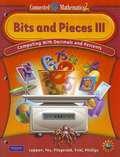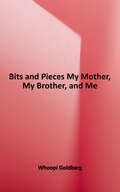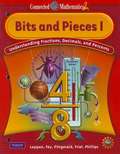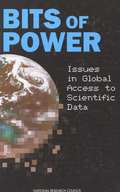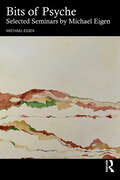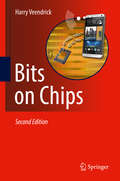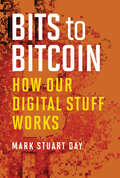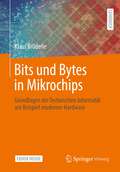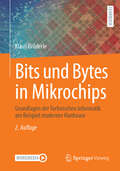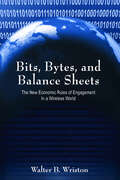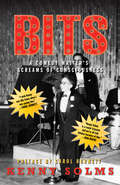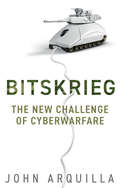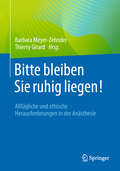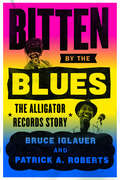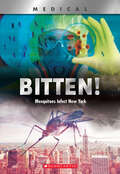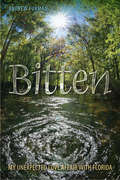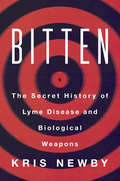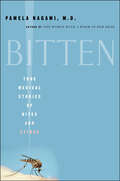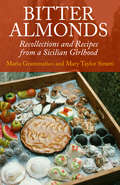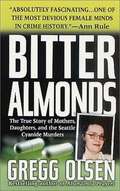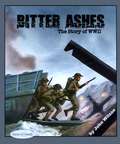- Table View
- List View
Bits and Pieces III Computing With Decimals and Percents
by Glenda Lappan James T. Fey William M. Fitzgerald Susan N. Friel Elizabeth Difanis PhillipsNIMAC-sourced textbook
Bits and Pieces III, Computing With Decimals and Percents
by Glenda Lappan James T. Fey William M. Fitzgerald Susan N. Friel Elizabeth Difanis PhillipsNIMAC-sourced textbook
Bits and Pieces: My Mother, My Brother, and Me
by Whoopi GoldbergFrom multi-award winner, Whoopi Goldberg comes a new and unique memoir of her family and their influence on her early life. If it weren't for Emma Johnson, Caryn Johnson would have never become Whoopi Goldberg. Emma gave her children the loving care and wisdom they needed to succeed in life, always encouraging them to be true to themselves. When Whoopi lost her mother in 2010--and then her older brother, Clyde, five years later--she felt deeply alone; the only people who truly knew her were gone. Emma raised her children not just to survive, but to thrive. In this intimate and heartfelt memoir, Whoopi shares many of the deeply personal stories of their lives together for the first time. Growing up in the projects in New York City, there were trips to Coney Island, the Ice Capades, and museums, and every Christmas was a magical experience. To this day, she doesn't know how her mother was able to give them such an enriching childhood, despite the struggles they faced--and it wasn't until she was well into adulthood that Whoopi learned just how traumatic some of those struggles were. Fans of personal memoirs such as Finding Me by Viola Davis and In Pieces by Sally Field will be touched by Bits and Pieces: a moving tribute from a daughter to her mother, and a beautiful portrait of three people who loved each other deeply. Whoopi writes, "Not everybody gets to walk this earth with folks who let you be exactly who you are and who give you the confidence to become exactly who you want to be. So, I thought I'd share mine with you."
Bits and pieces I, Understanding Fractions, Decimals, and Percents
by Glenda Lappan James T. Fey William M. Fitzgerald Susan N. Friel Elizabeth Difanis PhillipsNIMAC-sourced textbook
Bits of Power: Issues in Global Access to Scientific Data
by Committee on Issues in the Transborder Flow of Scientific DataSince Galileo corresponded with Kepler, the community of scientists has become increasingly international. A DNA sequence is as significant to a researcher in Novosibirsk as it is to one in Pasadena. And with the advent of electronic communications technology, these experts can share information within minutes. What are the consequences when more bits of scientific data cross more national borders and do it more swiftly than ever before? Bits of Power assesses the state of international exchange of data in the natural sciences, identifying strengths, weaknesses, and challenges. The committee makes recommendations about access to scientific data derived from public funding. The volume examines: Trends in the electronic transfer and management of scientific data. Pressure toward commercialization of scientific data, including the economic aspects of government dissemination of the data. The implications of proposed changes to intellectual property laws and the role of scientists in shaping legislative and legal solutions. Improving access to scientific data by and from the developing world. Bits of Power explores how these issues have been addressed in the European Community and includes examples of successful data transfer activities in the natural sciences. The book will be of interest to scientists and scientific data managers, as well as intellectual property rights attorneys, legislators, government agencies, and international organizations concerned about the electronic flow of scientific data.
Bits of Psyche: Selected Seminars by Michael Eigen
by Michael EigenThis book includes material from Michael Eigen’s celebrated and long-running seminar series, to explore some of the classic and contemporary key concepts in psychoanalytic theory and practice.Drawing on the work of Winnicott, Bion and Lacan, Eigen explores key psychoanalytic themes which have risen to prominence over the last decade such as the place of politics in psychoanalysis, life, death and psychic deadness, and the role of lies and deception in the consulting room and our world.With over 50 years of experience in leading seminars and working psychoanalytically, Eigen's work is essential reading for all psychoanalysts and psychoanalytic psychotherapists.
Bits on Chips
by Harry VeendrickThis book provides readers with a broad overview of integrated circuits, also generally referred to as micro-electronics. The presentation is designed to be accessible to readers with limited, technical knowledge and coverage includes key aspects of integrated circuit design, implementation, fabrication and application. The author complements his discussion with a large number of diagrams and photographs, in order to reinforce the explanations. The book is divided into two parts, the first of which is specifically developed for people with almost no or little technical knowledge. It presents an overview of the electronic evolution and discusses the similarity between a chip floor plan and a city plan, using metaphors to help explain concepts. It includes a summary of the chip development cycle, some basic definitions and a variety of applications that use integrated circuits. The second part digs deeper into the details and is perfectly suited for professionals working in one of the semiconductor disciplines who want to broaden their semiconductor horizon.
Bits to Bitcoin: How Our Digital Stuff Works (The\mit Press Ser.)
by Mark Stuart DayAn accessible guide to our digital infrastructure, explaining the basics of operating systems, networks, security, and other topics for the general reader.Most of us feel at home in front of a computer; we own smartphones, tablets, and laptops; we look things up online and check social media to see what our friends are doing. But we may be a bit fuzzy about how any of this really works. In Bits to Bitcoin, Mark Stuart Day offers an accessible guide to our digital infrastructure, explaining the basics of operating systems, networks, security, and related topics for the general reader. He takes the reader from a single process to multiple processes that interact with each other; he explores processes that fail and processes that overcome failures; and he examines processes that attack each other or defend themselves against attacks. Day tells us that steps are digital but ramps are analog; that computation is about “doing something with stuff” and that both the “stuff” and the “doing” can be digital. He explains timesharing, deadlock, and thrashing; virtual memory and virtual machines; packets and networks; resources and servers; secret keys and public keys; Moore's law and Thompson's hack. He describes how building in redundancy guards against failure and how endpoints communicate across the Internet. He explains why programs crash or have other bugs, why they are attacked by viruses, and why those problems are hard to fix. Finally, after examining secrets, trust, and cheating, he explains the mechanisms that allow the Bitcoin system to record money transfers accurately while fending off attacks.
Bits und Bytes in Mikrochips: Grundlagen der Technischen Informatik am Beispiel moderner Hardware
by Klaus BrüderleDieses Lehrbuch bietet einen gut verständlichen Einstieg in die technischen Grundlagen der Informatik, ohne tiefgehende mathematische Vorkenntnisse vorauszusetzen. Dank zahlreicher Übungen und Lösungen eignet sich das Buch hervorragend zum Selbststudium.Neben Grundkenntnissen der Computertechnik werden ebenso die technischen Grundlagen der Industrie 4.0 vermittelt. Ob Sie sich im Studium oder in der Ausbildung befinden, sich für digitale Berufe umqualifizieren möchten oder einfach ein interessierter Laie sind, dieses Buch unterstützt Sie bei Ihrer digitalen Weiterbildung.
Bits und Bytes in Mikrochips: Grundlagen der Technischen Informatik am Beispiel moderner Hardware
by Klaus BrüderleDieses Lehrbuch bietet einen gut verständlichen Einstieg in die technischen Grundlagen der Informatik, ohne tiefgehende mathematische Vorkenntnisse vorauszusetzen. Dank zahlreicher Übungen und Lösungen eignet sich das Buch hervorragend zum Selbststudium. Neben Grundkenntnissen der Computertechnik werden ebenso die technischen Grundlagen der Industrie 4.0 vermittelt. Ob Sie sich im Studium oder in der Ausbildung befinden, sich für digitale Berufe umqualifizieren möchten oder einfach ein interessierter Laie sind, dieses Buch unterstützt Sie bei Ihrer digitalen Weiterbildung. Der Inhalt Zeichen und Bits im Computer: Mensch und Maschine Verbindung der Chips (bis PCIe 7.0 und CXL, bis USB4 2.0 und Thunderbolt 5) Datenträger (HD, PCIe-5.0-SSDs), IOPS, Flash-Technik und Chipsätze bis Intel Serie-700 Arbeitsspeicher bis DDR5, XMP, SO-DIMM, LPDDR-SDRAM, CAMM und Konfiguration des DDR- und LPDDR-SDRAM (Intel, bis Core i-14000(K)) – Zwischenspeicher (Cache) Prozessor-Technologien: Single- und Multithreading, TDP, Power Limits bis 14. CPU-Gen (Raptor Lake Refresh), PWM-Regelung, alles über 12. bis 14. CPU-Generation, Total Hybrid: Chiplets (Tiles), 14. CPU-Mobil-Gen. Core Ultra (Serie 1) Meteor Lake Künstliche Intelligenz: Inferencing, Machine Learning, Datenformate (FP16, BF16 usw.), KI-Rechenwerke der CPU, der GPU und NPU Embedded (Mini PCs usw.) Core Ultra (Hybrid, Serie 1) Elektrischer Strom, Spannung, Leistung, Kondensator usw. Anhang von A (API …) über S (Supercomputer …) bis W (Workstationen) Die Zielgruppen An digitaler Weiterbildung Interessierte Schüler*innen mit dem Fach Informatik Schüler*innen an Berufsfachschulen, Technikerschulen mit Schwerpunkt Informatik und Informatik-Profil-Schulen (IPS) Techniker-Lehrgänge (DAA-Technikum, Fachinformatiker) Studierende der Fächer Informatik, Mechatronik u. a. Der Autor Dipl. Ing. (FH) Klaus Brüderle war Lehrer für Physik und Informatik und verfügt über vier Jahrzehnte Erfahrung in der IT-Bildung.
Bits, Bytes, and Balance Sheets: The New Economic Rules of Engagement in a Wireless World
by Walter B. WristonThis follow-up to the author's Twilight of Sovereignty explores the consequences of the changes produced by the new economy of the Internet, defining the new rules and examining some of the promising initiatives under way to create a system of measuring and valuing assets that reflects our new economic realities. Wriston shows that in today's economy, intellectual capital is more important than physical capital—and that businesses must adapt to this change or perish.
Bits: A Comedy Writer's Screams of Consciousness
by Kenny SolmsAnne Frank wrote her diary. A yawn. Alex Haley wrote about his roots. A snooze. The Bible. What a bore! But what do all these have in common? That's obvious. They're not funny and the people they wrote about aren't current. Where's Bieber? Jolie? Beyonce? That's who people want to read about and laugh about. Celebrities! And not written by the celebrities themselves. What do they know? If they were smart, they wouldn't have become celebrities in the first place. Who really knows their stories?It's the writer! The guy who was there in the trenches, the guy who made them famous in the first place. Actors and actresses didn't write their lines. It was the writer!Who knew these stars before they became egomaniacs? Before they even knew the difference between Calistoga or Evian? The difference between dark chocolate or milk? Who told them what to say and how to say it? Writers, writers, writers!Kenny Solms has seen them all. He wrote and schmoozed with the best of them. Co-creating the Carol Burnett show in the late 60s, he's written for practically all of them. (However, he has yet to meet Leonardo DeCaprio). Solms wrote their movies, their TV shows. . . . even their "spontaneous" quotes. From the greats like Jack Benny and George Burns to Willard Scott and downwards. But then back up again. And that's quite a leap. He's the one whose bits Lucille Ball uttered. He got Bill Cosby his laughs. Sure, he made millions doing it and garnered a few Emmys as well, but is he cocky? Not remotely. In this Hollywood "tell-all" book, he documents his rise from the Emmy award-winning "Carol Burnett Show" to his doldrums writing for Hugh Hefner's "Roller Disco-Rama Plus a Preview of the Playmate of the 80s. " From the booms to the boobs. From the genius of Michael Jackson tothe hilarity of Joan Rivers, Solms seems to know everybody. Streisand, Sammy Davis Jr. , Neil Diamond. He's written for them all. Even the Muppet, Miss Piggy, who he claims was a bitch. But this book isn't namedropping. Jack Nicholson is one of his best friends. Or malicious gossip. Placido Domingo hitting on Carol Burnett. It's not even a vicious tell-all but tell all, he does. A funny romp that takes you from Philadelphia to Hollywood. A cruise behind the Hollywood scenes, down the freeways, up the canyons and then some. From variety shows to sitcoms, from big star specials to Broadway, he shares his roller coaster ride from writing tacky one-liners to creating TV classics. And what a ride! Jump in the passenger seat and share it with him.
Bitskrieg: The New Challenge of Cyberwarfare
by John ArquillaNew technologies are changing how we protect our citizens and wage our wars. Among militaries, everything taken for granted about the ability to maneuver and fight is now undermined by vulnerability to “weapons of mass disruption”: cutting-edge computer worms, viruses, and invasive robot networks. At home, billions of household appliances and other “smart” items that form the Internet of Things risk being taken over, then added to the ranks of massive, malicious “zombie” armies. The age of Bitskrieg is here, bringing vexing threats that range from the business sector to the battlefield. In this new book, world-renowned cybersecurity expert John Arquilla looks unflinchingly at the challenges posed by cyberwarfare – which he argues have been neither met nor mastered. He offers fresh solutions for protecting against enemies that are often anonymous, unpredictable, and capable of projecting force and influence vastly disproportionate to their size, strength, or wealth. The changes called for require radical rethinking of military and security affairs, diplomacy, and even the routines of our daily lives.
Bitstream
by Michael J. RobertsFocuses on the new CEO of a growing software firm, the culture he's tried to create, and the need to hire a manager to spearhead a new product division. Includes details on how the search was conducted and presents resumes of four candidates who are being considered for the position. Designed to allow students to think through the recruitment, selection, and interview process.
Bitte bleiben Sie ruhig liegen!: Alltägliche und ethische Herausforderungen in der Anästhesie
by Barbara Meyer-Zehnder Thierry GirardDieses Buch beschreibt alltägliche und ethische Herausforderungen in der Anästhesiologie und zeigt auf, wie diese gemeistert werden können: im Operationssaal, im Aufwachraum, im Schockraum oder in der Prämedikationsambulanz. Themen sind u.a. Grundlagen und Methoden der Medizinethik, Arbeitsbedingungen in der Anästhesie, Bedeutung des Patientenwillens, die Rolle des Nocebo-Effekts, das Verhältnis von Anästhesiologie und Chirurgie aus verschiedener Perspektive, Behandlung und Betreuung betagter Menschen, Probleme und Tücken im Aufwachraum, Herausforderungen in der Anästhesiepflege oder in der Schmerztherapie. Das Buch richtet sich an Anästhesistinnen und Anästhesisten und bietet auch Pflegenden in der Anästhesie sowie Mitarbeitenden im Rettungsdienst interessante Aspekte.
Bitten by the Blues: The Alligator Records Story (Chicago Visions and Revisions)
by Bruce Iglauer Patrick A. RobertsIt started with the searing sound of a slide careening up the neck of an electric guitar. In 1970, twenty-three-year-old Bruce Iglauer walked into Florence’s Lounge, in the heart of Chicago’s South Side, and was overwhelmed by the joyous, raw Chicago blues of Hound Dog Taylor and the HouseRockers. A year later, Iglauer produced Hound Dog’s debut album in eight hours and pressed a thousand copies, the most he could afford. From that one album grew Alligator Records, the largest independent blues record label in the world. Bitten by the Blues is Iglauer’s memoir of a life immersed in the blues—and the business of the blues. No one person was present at the creation of more great contemporary blues music than Iglauer: he produced albums by Koko Taylor, Albert Collins, Professor Longhair, Johnny Winter, Lonnie Mack, Son Seals, Roy Buchanan, Shemekia Copeland, and many other major figures. In this book, Iglauer takes us behind the scenes, offering unforgettable stories of those charismatic musicians and classic sessions, delivering an intimate and unvarnished look at what it’s like to work with the greats of the blues. It’s a vivid portrait of some of the extraordinary musicians and larger-than-life personalities who brought America’s music to life in the clubs of Chicago’s South and West Sides. Bitten by the Blues is also an expansive history of half a century of blues in Chicago and around the world, tracing the blues recording business through massive transitions, as a genre of music originally created by and for black southerners adapted to an influx of white fans and musicians and found a worldwide audience. Most of the smoky bars and packed clubs that fostered the Chicago blues scene have long since disappeared. But their soul lives on, and so does their sound. As real and audacious as the music that shaped it, Bitten by the Blues is a raucous journey through the world of Genuine Houserockin’ Music.
Bitten!: Mosquitoes Infect New York (XBooks: Medical)
by John SheaSix New Yorkers are sick with a mysterious virus that attacks the brain.Experts suspect a tiny culprit: mosquitoes! Then birds start dropping dead. Scientists think that the outbreaks are related. But how?High-interest topics, real stories, engaging design, and astonishing photos are the building blocks of the XBooks, a new series of books designed to engage and motivate reluctant and enthusiastic readers alike. How can a bite from a pet prairie dog cause a life-threatening illness? Where does the guinea worm, a parasite that lives under human skin, come from? How can a virus that attacks the brain be related to birds dropping dead at the zoo? With topics based in science, these action-packed books will help students unlock the power and pleasure of reading... and always ask for more!
Bitten: My Unexpected Love Affair with Florida
by Andrew FurmanWhen Andrew Furman left the rolling hills of Pennsylvania behind for a new job in Florida, he feared the worst. While he’d heard much of the fabled “southern charm,” he wondered what could possibly be charming about fist-sized mosquitoes, oppressive humidity, and ever-lurking alligators.It wasn’t long before he began to notice that the real Florida right outside his office window was very different from the stereotypes portrayed in movies, television, and even state-promoted tourism advertisements. In Bitten, Furman shares his amazement at the beautiful and the bizarre of his adopted state. Over seventeen years, he and his family have shed their Yankee sensibilities and awakened to the terra incognita of their new home.As he learns to fish for snook—a wily fish that inhabits, among other areas, the concrete-lined canals that crisscross the state—and seeks out the state’s oldest live oak, a behemoth that pre-dates Columbus, Furman realizes that falling in love with Florida is a fun and sometimes humbling process of discovery. Each chapter highlights a fascinating aspect of his journey into the natural environment he once avoided, from snail kites to lizards and cassia to coontie.Sharing his attempts at night fishing, growing native plants, birding, and hiking the Everglades, Furman will inspire you to explore the real Florida. And, if you aren’t lucky enough to reside in the Sunshine State, he’ll at least convince you to unplug for an hour or two and enjoy the natural beauty of wherever it is you call home.
Bitten: The Secret History of Lyme Disease and Biological Weapons
by Kris NewbyA riveting thriller reminiscent of The Hot Zone, this true story dives into the mystery surrounding one of the most controversial and misdiagnosed conditions of our time—Lyme disease—and of Willy Burgdorfer, the man who discovered the microbe behind it, revealing his secret role in developing bug-borne biological weapons, and raising terrifying questions about the genesis of the epidemic of tick-borne diseases affecting millions of Americans today.While on vacation on Martha’s Vineyard, Kris Newby was bitten by an unseen tick. That one bite changed her life forever, pulling her into the abyss of a devastating illness that took ten doctors to diagnose and years to recover: Newby had become one of the 300,000 Americans who are afflicted with Lyme disease each year.As a science writer, she was driven to understand why this disease is so misunderstood, and its patients so mistreated. This quest led her to Willy Burgdorfer, the Lyme microbe’s discoverer, who revealed that he had developed bug-borne bioweapons during the Cold War, and believed that the Lyme epidemic was started by a military experiment gone wrong.In a superb, meticulous work of narrative journalism, Bitten takes readers on a journey to investigate these claims, from biological weapons facilities to interviews with biosecurity experts and microbiologists doing cutting-edge research, all the while uncovering darker truths about Willy. It also leads her to uncomfortable questions about why Lyme can be so difficult to both diagnose and treat, and why the government is so reluctant to classify chronic Lyme as a disease.A gripping, infectious page-turner, Bitten will shed a terrifying new light on an epidemic that is exacting an incalculable toll on us, upending much of what we believe we know about it.
Bitten: True Medical Stories of Bites and Stings
by Pamela NagamiWe've all been bitten. And we all have stories.The bite attacks featured in this dramatic book take place in big cities, small towns, and remote villages around the world and throughout history. Some are as familiar and contemporary as encounters with mosquitoes in New York City and snakes in southern California's Hollywood Hills or as exotic and foreign as the tsetse in equatorial Africa, the camel in Riyadh, and the Komodo dragon in Indonesia. While others, such as people biting other people---well, these are in a category of their own.Among the startling stories and fascinating facts in Bitten.o A six-year-old girl descends into weeks of extreme lassitude until a surgeon plucks an engorged tick from her scalp.o A diabetic living in the West Indies awakes one morning to a rat eating his left great and second toes.o A twenty-eight-year-old man loses a third of his nose to a bite by his wife.o In San Francisco, after a penile bite, a man develops "flesh-eating strep," which spreads to his lower abdomen.o Severe bites by rabid animals to the face and digits, because of their rich nerve supply, are the most likely to lead to rabies and have the shortest incubation periods.o Following the bite of a seal or contact with its tissues, sealers develop such agonizing pain and swelling in their bites that, far from medical care, they sometimes amputate their own fingers.o Perhaps the most devastating human bite wound injuries are those involving the nose; doctors in Boroko near Papua, New Guinea, reported a series of ninety-five human bites treated in the Division of Surgery from 1986 to 1992---twelve were to the nose, nine in women, and three in men, and in most of the cases, the biter was an angry spouse.With reports from medical journals, case histories, colleagues, and from her own twenty-eight-year career as a practicing physician and infectious diseases specialist, Pamela Nagami's Bitten offers readers intrigued by human infection and disease and mesmerized by creatures in p0the wild a compulsively readable narrative that is entertaining, sometimes disgusting, and always enjoyable.
Bitter
by Jennifer MclaganThe champion of uncelebrated foods including fat, offal, and bones, Jennifer McLagan turns her attention to a fascinating, underappreciated, and trending topic: bitterness. What do coffee, IPA beer, dark chocolate, and radicchio all have in common? They're bitter. While some culinary cultures, such as in Italy and parts of Asia, have an inherent appreciation for bitter flavors (think Campari and Chinese bitter melon), little attention has been given to bitterness in North America: we're much more likely to reach for salty or sweet. However, with a surge in the popularity of craft beers; dark chocolate; coffee; greens like arugula, dandelion, radicchio, and frisée; high-quality olive oil; and cocktails made with Campari and absinthe--all foods and drinks with elements of bitterness--bitter is finally getting its due. In this deep and fascinating exploration of bitter through science, culture, history, and 100 deliciously idiosyncratic recipes--like Cardoon Beef Tagine, White Asparagus with Blood Orange Sauce, and Campari Granita--award-winning author Jennifer McLagan makes a case for this misunderstood flavor and explains how adding a touch of bitter to a dish creates an exciting taste dimension that will bring your cooking to life. From the Hardcover edition.
Bitter & Sweet: Global Flavors from an Iranian-American Kitchen
by Omid RoustaeiDiscover a world of flavors in this elegantly designed cookbook from Omid Roustaei—the Caspian Chef—featuring 75 mouthwatering recipes that blend Iranian dishes with global cuisines, accompanied by moving stories of Omid&’s life and culinary journey from Iran to the US. Bitter & Sweet is an elegantly designed cookbook featuring 75 mouthwatering recipes from Omid Roustaei, the Caspian Chef. Infused with moving stories, useful cooking tips, and gorgeous photographs, Bitter & Sweet teaches readers to experiment not only with Iranian dishes but also with the many cuisines and techniques that Omid has explored throughout his career. His welcoming prose and down-to-earth methods are sure to engage both practiced hands and total newcomers to the kitchen. Recipes include Persian classics like Chicken in Pomegranate Walnut Sauce (Khoresh Fesenjun), Sour Cherry Rice with Petite Meatballs (Albalu Polo ba Ghel Gheli), and Rice with a Crispy Saffron Layer (Polo ba Tahdig) alongside international dishes such as Braised Burdock with Carrots (Kinpira Gobo), Creamy Smoked Fish and Vegetable Soup (Cullen Skink), and Fried Potato and Bulgur Kibbeh (Kibbet Batata bil Lahmeh). ACCESSIBLE: Written in a conversational format that makes this complex and delicious cuisine easy to cook for anyone, regardless of experience. IMPROVISATIONAL: Each recipe includes simple tips for modification based on what you have on hand, with deeper instruction on how to become a more mindful and intuitive cook. NARRATIVE-DRIVEN: Each chapter features a moving story from Omid&’s life and the impact it had on his culinary journey from Iran to the US. INSPIRING: Bitter & Sweet is a love letter to food&’s ability to bridge cultures, sparking curiosity and underscoring humanity&’s need for connection and belonging.
Bitter Almonds
by Mary Taylor Simeti Maria GrammaticoAt the age of eleven, the daughter of a Sicilian sharecropper, Maria Grammatico, entered the San Carlo Institute in the mountaintop town of Erice, an orphanage run by nuns who were famous throughout Sicily for their almond pastries, but who were less adept at dealing with young girls. After ten years of hard work and harsh discipline, Maria emerged with the secrets of the nuns' pastries hidden inside her head. This is the story of her carefree country childhood--her Dickensian life in the orphanage with no heat, no running water, and only wood-burning ovens--and her triumphs as an entrepreneur and a world-famous pastry chef. Bitter Almonds includes 46 of the recipes that she 'stole' from the nuns, committed to writing for the first time in these pages.
Bitter Almonds: The True Story of Mothers, Daughters, and the Seattle Cyanide Murders
by Gregg OlsenIn an attempt to cover her tracks, Stella did the unconscionable. She saw to it that a stranger would also become a "random casualty" of cyanide-tainted painkillers. But Stella's cunning plan came undone when her daughter Cynthia notified federal agents. And troubling questions lingered like the secret of bitter almonds...
Bitter Ashes: The Story of WW II
by John WilsonWorld War Two was the greatest conflict in human history. It gave birth to the Atomic Age, the Cold War and the economic boom of the 1950s and 60s, and planted the seeds of today’s Middle East crises. But it is not distant history. Most Canadians have relatives who were part of this world-wide tragedy. Bitter Ashes puts these events in context for them. This book in the illustrated historical series Stories of Canada is a companion to Desperate Glory: The Story of WWI. A clear and concise text leads the reader though the major military and political events and issues of the war. Sidebars add detail and a personal element. Every page is illustrated with either photographs or maps.
